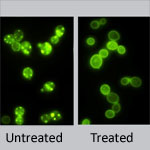This page is historical material reflecting the Feedback Loop Blog as it existed on
November 6, 2013. This page is no longer updated and links to external websites
and some internal pages may not work.
November 6, 2013
Treating yeast cells with the NAB compound reverses the toxic effects of elevated levels of alpha synuclein protein. Credit: Daniel Tardiff, Whitehead Institute.
View larger image
These eye-catching images and the NIGMS-funded research that yielded them were
recently featured by NIH Director Francis Collins on his blog. Scientists led by a team at the Whitehead Institute for Biomedical Research engineered yeast to produce too much of a protein, alpha synuclein. In Parkinson’s disease, elevated levels or mutated forms of this protein wreak havoc on the cell. Using the model system, the researchers tested tens of thousands of compounds to identify any that reversed the toxic effects. One did. The compound, abbreviated NAB, worked similarly in an animal model and in rat neurons grown in a lab dish. Collins described the approach as “an innovative strategy for drug hunting that will likely be extended to other conditions.”

